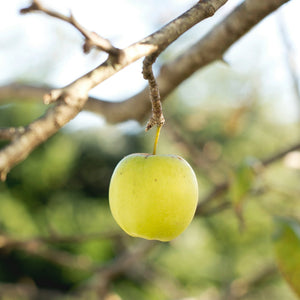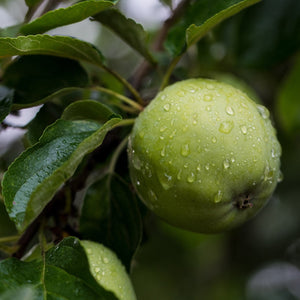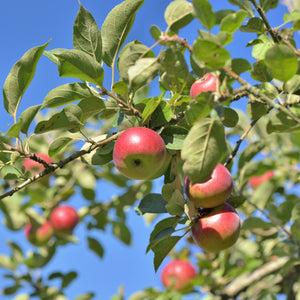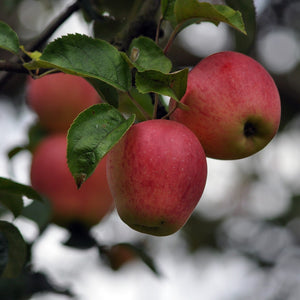The Apple Tree Guide
Apple trees (Malus spp.) are among the most popular fruit trees in North America, prized for their delicious fruit, spring blossoms, and ornamental appeal. With hundreds of varieties to choose from—ranging from heritage cultivars to disease-resistant modern selections—apple trees can suit a wide range of climates, garden sizes, and culinary preferences. Whether you're planting a single specimen in a backyard or establishing a home orchard, apple trees offer years of reward with proper care.

About
Apple trees belong to the genus Malus, with Malus domestica being the most commonly cultivated species. Native to Central Asia, apples have been grown for thousands of years and are now a staple of temperate-region agriculture across the globe. These deciduous trees are celebrated for their fragrant white or pink flowers in spring and colorful fruit in late summer to fall.
There are numerous apple cultivars available, each offering distinct flavor profiles, textures, and uses:
- Malus 'Honey Crisp', known for its juicy crunch and balanced sweetness, is ideal for fresh eating.
- Malus 'Fuji' and Malus 'Gala' offer reliably sweet fruit and long storage life.
- Malus 'Granny Smith' produces tart green apples perfect for baking and cider.
- Malus 'McIntosh', Malus 'Winesap', and Malus 'Jonathan' are time-tested heritage types with complex flavor and excellent cooking potential.
- Columnar cultivars like Malus 'Scarlet Sentinel' or dwarf trees like Malus 'Golden Treat' are excellent for small-space or container growing.
Apple trees require cross-pollination for best fruit production, so planting at least two compatible varieties within close proximity is essential unless you're growing a self-fertile type.

PLANTING
Planting an apple tree successfully starts with site selection and timing:
- USDA Hardiness Zones: Most apple varieties grow best in Zones 4–8.
- Soil: Well-drained, loamy soil with a neutral to slightly acidic pH is ideal.
- Sunlight: Full sun is crucial—at least 6–8 hours of direct light daily.
- Spacing: Standard trees should be spaced 15–20 feet apart, semi-dwarf trees 12–15 feet, and dwarf varieties 8–10 feet apart.
- Planting Time: Plant in early spring or late fall while the tree is dormant.
Dig a hole twice as wide as the root ball but no deeper. Place the tree so the graft union (if visible) sits a few inches above soil level. Backfill with native soil, water deeply, and apply mulch around the base, keeping it away from the trunk.

CARE
Caring for apple trees involves seasonal maintenance and long-term observation:
- Watering: Provide deep, consistent moisture in the first two years while the tree establishes. Mature trees may need less frequent watering but benefit from supplemental irrigation in drought conditions.
- Fertilizing: Apply a balanced, slow-release fertilizer in early spring. Avoid over-fertilizing, which can lead to excessive foliage and fewer flowers.
- Pruning: Prune in late winter to early spring to remove dead or crossing branches, improve airflow, and maintain an open center or central leader shape.
- Thinning Fruit: Once fruit sets, thin to one apple per cluster to ensure larger, healthier fruit and reduce limb stress.
- Pest & Disease Control: Monitor for common issues such as apple scab, fire blight, and codling moths. Use integrated pest management (IPM) strategies and select disease-resistant cultivars where possible.
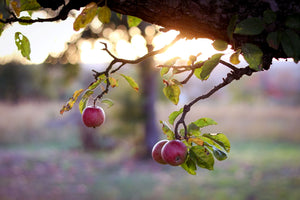
HOW TO USE
Apple trees serve multiple purposes in home gardens and orchards:
- Edible Landscapes: Apples are a classic choice for edible gardens, providing fresh fruit for eating, cooking, baking, and preserving.
- Ornamental Value: Spring blooms and fall color add ornamental interest, especially from varieties like Malus 'Pink Lady' and Malus 'Royal Gala'.
- Backyard Orchards: Combine with other fruit trees like pears, plums, or cherries for a diverse harvest.
- Small Spaces: Dwarf cultivars such as Malus 'Golden Treat' and Malus 'Scarlet Sentinel' work well in containers or tight gardens.
- Pollinator Support: Spring blossoms are attractive to bees and other early pollinators.
Pair apple trees with underplantings of flowering herbs like thyme or shallow-rooted perennials that don't compete heavily for nutrients.
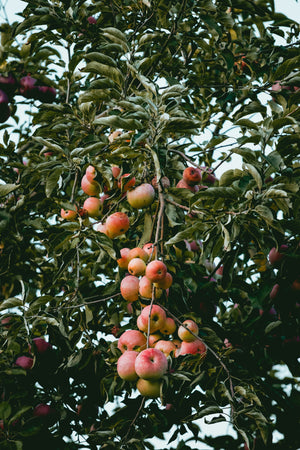
Common Questions
- How to prune apple trees? Prune in late winter to shape the tree, improve airflow, and remove dead, damaged, or inward-growing branches.
- When to prune apple trees? Best done while the tree is dormant—usually in late winter to early spring, before new growth begins.
- How long does an apple tree take to grow? Apple trees take 2–3 years to become established and may begin producing small harvests in year 3 or 4, with full production by year 6–8.
- How to plant an apple tree? Choose a sunny location, plant at the correct depth with good drainage, and water thoroughly after planting.
- How long does it take for an apple tree to produce apples? Most apple trees begin fruiting within 3–5 years, though dwarf varieties may bear fruit slightly earlier.
Conclusion
Apple trees are a rewarding and productive addition to any landscape. With the right care and cultivar selection, you can enjoy fragrant spring flowers, vibrant autumn color, and fresh apples for years to come. Whether you’re planting Malus 'Honey Crisp' for snacking or Malus 'Granny Smith' for pies, growing your own apples connects you to the rhythm of the seasons and offers a delicious harvest that’s hard to beat.
The Apple Collection
Sold Out
Sold Out


